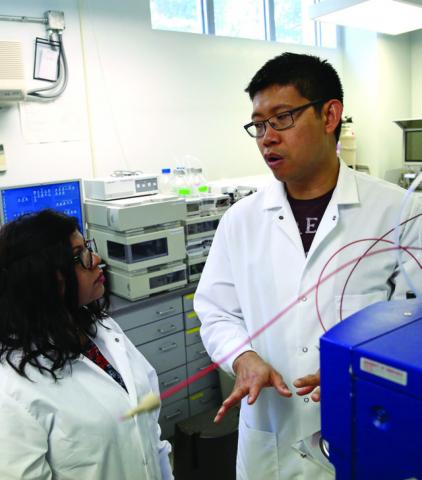The Water Sciences Lab (WSL) had a landmark year in 2020.
The lab celebrated its 30th anniversary in style with new equipment, a renovated interior and commemorative publications. Then the global pandemic forced it to reconfigure operations. With numerous samples on deadline to be analyzed, WSL nimbly balanced new safety precautions with responsibilities to clients. The lab was among the first campus facilities to partially reopen following the COVID-19 shutdown.
The lab entered 2020 with a new Xevo TQS triple quadrupole mass spectrometer. The state-of-the-art mass spec is able to measure contaminants with 1,000 times the sensitivity of its older counterpart. In the fall, WSL co-hosted a technical workshop series with Waters Corporation — who makes the instrument — to train water scientists and professionals on its wide range of capabilities. The virtual workshops included presentations from a variety of institutions and countries and were attended by over 200 individuals representing universities, laboratories, government agencies, and private companies. Moreover, the facility has several current projects with Nebraska stakeholders, including Nebraska
Lake Management; the Nemaha, Central Platte, Lower Platte South, Lower Platte North, Lower Loup and Upper Big Blue Natural Resources Districts; and Nebraska Game and Parks Commission, among others.
To grow awareness of the lab’s capabilities, we developed a new brochure in partnership with University Communication. Additionally, a special edition of the Nebraska Water Current newsletter celebrated the lab’s 30th anniversary through interviews with past and current lab members and leaders. Furthermore, the lab launched two new videos: a virtual
tour of the facility and another on the Nebraska Vadose Zone project (see article on p. 12).
At the end of 2020, WSL took advantage of a federal surplus loan to educational institutions. This enabled it to add a relatively new inductively coupled plasma optical emission spectrometer (ICP-OES) and ion chromatography system from a Food and Drug Administration laboratory to its growing list of state-of-the-art equipment.
Looking ahead, WSL will launch a new environmental laboratory course (NRES 439/839) in fall 2021 for undergraduate and graduate students. Students wishing to pursue future laboratory positions, gain experiences to grow in academia or build stronger understandings of lab methods in environmental sciences will learn the analytical technologies and practices found in environmental laboratory testing. Environmental methods are unique in that they require a high level of measuring, quality control and management. Good laboratory practices ensure that results are consistent, reliable and reproducible at increasingly low concentrations.
Staff changes included the addition of Victoria Dey and Nathan Roddy. Victoria holds a B.S. in natural resource sciences from the University of Nebraska–Lincoln and serves as the lab’s research technician running the inductively coupled plasma mass spectrometer (ICP-MS) for trace elements. She also manages documentation, coordinates student training and organic contaminant methods. Nathan Roddy was recruited
in fall 2020 to fill the isotope scientist position vacated by Aaron Shultis. He now runs the facility’s stable isotope and age dating instrumentation.
For more information on the lab, visit: watercenter.unl.edu/wsl

